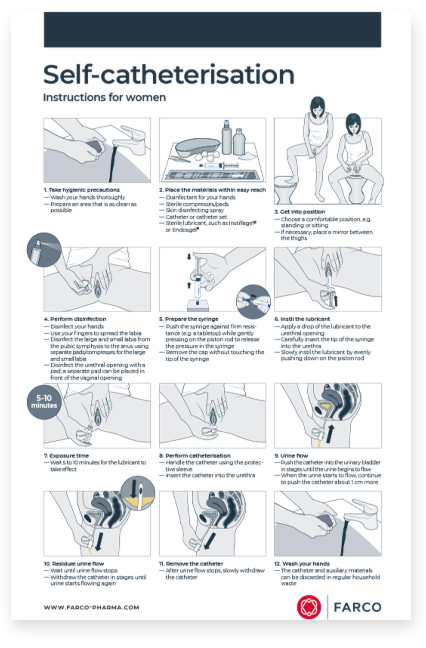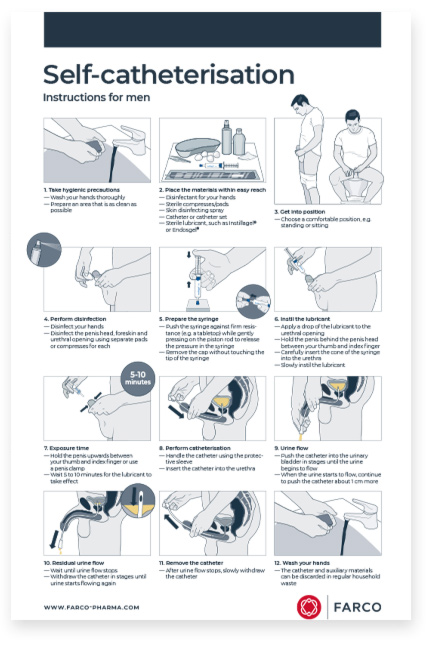Instructions and tips for self-catheterisation
Intermittent self-catheterisation
It is relatively easy to learn how to perform self-catheterisation. Many patients appreciate the ability to perform self-catheterisation because it enables them to regain their mobility, self-reliance and independence from the assistance of others. Self-catheterisation can be learned at a hospital, clinic or at home with guidance from a physician or qualified professional.
We have condensed the most important self-catheterisation steps and tips here for you and we hope that our experience will assist you in overcoming any potential initial difficulties.
Preparations for self-catheterisation should be completed calmly and carefully. Check to ensure that you always have sufficient catheters and all of the corresponding materials on hand, including sterile and disinfecting lubricant, hand disinfectant, sterile pads and a skin disinfecting spray. Be sure to also keep a supply of all of the required materials wherever you spend a lot of time, e.g. at work, at the homes of friends and relatives, etc.
During the learning phase, it is best to sit in a half-reclining supine position on the bed. Later, you will be able to perform self-catheterisation while standing or while seated on the toilet, in the bath or in a wheelchair.
Self-catheterisation is typically required to be performed four to six times a day. In order to incorporate it as easily as possible into your daily routine, we recommend establishing a few regular habits. For example, it is advisable to start each day with a catheterisation. Other suitable opportunities include coffee breaks, breaks between classes at school or prior to meals.
Though difficult, it is especially important to create the most aseptic conditions possible for the procedure. Many common bacteria and microorganisms from our environment may cause urinary tract infections or inflammations of the bladder if they are passed through the catheter and into the urethra or bladder. The use of a sterile lubricant, such as Endosgel®, with ancillary disinfecting properties, or a lubricant with an additional local anaesthetic, such as Instillagel®, simplifies not only self-catheterisation, but also considerably enhances the protection of your health.
1. Take hygienic precautions
These include washing your hands and preparing an area that is as aseptic as possible to perform intermittent self-catheterisation.
Tip: Prepare a clean and (in a best-case scenario) disinfected serving tray for setting up the required materials and place a clean underlay on the spot where you will be sitting.
2. Place all of the required materials within easy reach
These include:
- Disinfectant for your hands
- Sterile pads
- Skin disinfecting spray
- Catheter or catheter set
- Sterile lubricant with ancillary desinfecting properties, such as Endosgel®, or a lubricant with an additional local anaesthetic, such as Instillagel®
- Mirror (for women)
- Possibly a penile clamp (for men)
Women should start out by placing a mirror between the legs (there are mirrors that can be secured to the thigh with a rubber band) in order to make it easier to locate the urethral opening. The urine is collected in a container (kidney dish) or bag that is often included in the catheter set or built into the catheter or passed directly into the toilet.

Materials for self-catheterisation
Tip: Carefully open the blister containing the sterile pads and lubricant without touching the contents with your hands and place them on the prepared tray. Tear open the sterile package containing the catheter along the perforated line and slide the catheter out of the sleeve about 8 - 10 cm without touching it. Set the catheter down in such a way that it does not come into contact with any unsterile surface. The best approach is to position the catheter in such a way that the exposed portion sticks out over the edge of the tray.
Without touching it, saturate the pad in the opened blister with the skin disinfecting spray.
Women: Set up the mirror first so that you no longer need to touch it after you have disinfected your hands.
3. Disinfection
Disinfect your hands first before you begin self-catheterisation. Men: Clean the urethral opening on the head of the penis next by pulling back the foreskin and applying a skin disinfecting spray or cleaning disinfectant.

Disinfecting the urethral opening in men
Women: Spread the labia using your fingers and clean and disinfect the opening of the vagina by applying a skin disinfecting spray or cleaning disinfectant.

Disinfecting the urethral opening in women
Tip: After you disinfect your hands, make sure you don't touch anything except the sterile materials and instruments. If you have to touch anything else, then repeat the disinfection process before you proceed with self-catheterisation.
During disinfection of the genital area, you should conclude the process by rubbing the urethral opening exactly one time with an unused, sterile pad that has been saturated with skin disinfecting spray. Rubbing the opening back and forth with the pad will not increase the disinfecting action, but instead may have the opposite effect because the repeated contact between the pad and the body may result in the intrducation of previously removed microorganisms to the cleaned area of the body. It is important to observe the exposure time for the disinfectant, as specified by the manufacturer.
4. Instilling the lubricant
Remove the syringe from the blister. Before removing the sealing cap, a possible pressure point should be loosened by lightly pressing the plunger (press the sealing cap against firm resistance). This enables easy and uniform emptying of the syringe. The sealing cap is then removed, as far as possible without touching the syringe tip. Apply a drop of the lubricant to the urethral opening to make it easier to insert the cone of the syringe.

Tip: Be careful not to touch the cone of the syringe when removing the cap.

Applying a drop of lubricant to the urethral opening in men

Applying a drop of lubricant to the urethral opening in women
Carefully insert the cone of the syringe into the urethral opening and slowly inject the lubricant by applying gentle and even pressure.
Men: Use your free hand to hold the head of the penis between your thumb and index finger in order to insert the cone of the syringe in such a way that no lubricant comes out of the urethra. Then hold the urethra closed using your thumb and index finger or a penile clamp until the exposure time of 5 - 10 minutes has elapsed so that no lubricant comes out of the urethra.

Holding the penis closed using fingers or the penile clamp during the exposure period for the lubricant
Important: Patients with hypersensitivities in the genital area and using a lubricant with a local anaesthetic, such as Instillagel®, should always observe the exposure time of at least 5 - 10 minutes before beginning the catheterisation process.
5. Catheterisation
Catheterisation in men
Hold the end of the catheter that is protected by the case and carefully insert the other end into the urethra, which has been expanded by the lubricant. Press your thumb and index finger together to secure the catheter in place while simultaneously removing the rest of the case from the catheter. Then relax your thumb and index finger and advance the catheter into the penis. This procedure is easy and ensures aseptic conditions, even without sterile gloves. Advance the catheter into the urinary bladder in stages until the urine begins to flow. Once the urine begins to flow, advance the catheter approx. 1 cm further into the urinary bladder. The lubricant in the urethra should make it possible to advance the catheter without any resistance. Never apply force when inserting a catheter.
The urine is collected in a urinary drainage bag or emptied into a container (kidney dish) or directly into the toilet. In the latter two cases, you must prepare the other end of the catheter case by cutting or tearing it open so that the urine is able to drain without the necessity of touching the catheter.
Wait until the urine flow stops and then slowly remove the catheter in stages.
Important: The male urethra has a curve upstream from the sphincter muscle. This must be handled with special care and gentle pressure. Tension on the penis may make it easier to advance the catheter. If the catheter has a curved tip, then it should be facing up toward the patient's face.
Tip: While inserting the catheter, never use your hands to touch the shaft of the catheter directly or to move the catheter backward toward the urethral opening.
A quick-reference guide to self-catheterisation in men can be found here.

Catheterisation in men
Catheterisation in women
Use your fingers to spread the inner and outer labia and open them slightly outward and upward to clearly expose the urethral opening. Hold the end of the catheter that is protected by the case and carefully insert the other end approx. 5 - 6 cm into the urethra until the urine begins to flow.
Once the urine begins to flow, advance the catheter approx. 1 cm further into the urinary bladder. The urine is collected in a urinary drainage bag or emptied into a container or directly into the toilet. In the latter two cases, you must prepare the other end of the catheter case by cutting or tearing it open so that the urine is able to drain without the necessity of touching the catheter.
Wait until the urine flow stops and then slowly remove the catheter in stages.
A quick-reference guide to self-catheterisation in women can be found here.

Catheterisation in women
Please consult the instructions for use of the corresponding manufacturer for special instructions concerning the handling of the various single-use catheters and catheter sets.












